Web Development Core

The Web Development Core is a resource for all researchers at Partners, affiliated institutions, and the biomedical industry to design and develop web sites for presenting their work and sharing their findings with other researchers and the public, as well as for sharing data confidentially among their own researchers.
We handle all aspects of web site creation, from consulting with you and determining your needs and audience, to designing the site, writing the text, photographing and illustrating it, doing any programming necessary, doing quality assurance of the site, reviewing it with you, and hosting and maintaining it for you. What makes us so useful is the fact that we handle the entire process, and we specialize in doing sites for researchers in medicine and molecular biology. We do our best to create the site quickly and economically.
Our philosophy is generally to keep the design straightforward and attractive, and to keep the client's content foremost, so the form reflects the content and is driven by it.
There is no charge for initial consultations through your acceptance of our proposal and estimate of costs.
Services
Our services include complete development of web sites for researchers at Partners and affiliated institutions, including MGH, Brigham and Women's, Dana-Farber, Spaulding, and the various institutes working with Partners researchers. We will meet with you to discuss your needs, your audience, and your budget, and submit a proposal at no charge.
Our capabilities include:
- Web site design and development: everything needed to go from idea to finished site
- We code using HTML, CSS, JavaScript and Flash, depending on the customer's needs
- We can create secure HIPAA-compliant sites using password protection and encryption
- Photography: high-quality digital scientific photography, including photographs of people, facilities, and macro photography
- Photo-quality printing: up to 13 by 19 inches on heavy-weight paper using an archival 8-color printer
- Writing and editing of technical material: we will work with you to write copy suitable for your site
Other web services are available, including quality assurance review and development work for dynamic sites. Following initial meetings to discuss client needs for a site, a flat rate for the creation of the site can usually be quoted once the scope of work is agreed upon. We try to be flexible, so please feel free to contact us to discuss our rates and your needs.
Contact Derwin Hyde for further information. Email or phone: 617-643-2081.
Portfolio
Here's our current portfolio of web sites. Click on any image or the corresponding headline to go to the site:
|
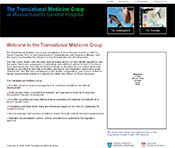 |
|
Translational Medicine Group
The Translational Medicine Group was founded by Dr. Mason Freeman to address the need to accelerate the advance of new therapeutics from their development in the laboratory to their use in clinical practice. The group works with basic science teams at MGH to identify targets for new therapies, then manages the study plan and oversees the clinical trials to determine the safety and efficacy of these therapies.
This site is only accessible from within the Partners network while under development.
|
|
 |
|
PROMISE Study
Currently under development, this site will go live in February of 2010. It will test and certify radiologists and cardiologists in their reading and assessment of CTA scans, and in their assessment of cardiac vessel stenosis. The software automatically scores the read results against a key containing the expert read results and returns the user's score.
This site is only accessible from within the Partners network while under development.
|
|
 |
|
Harris Center for Chordoma Care
When Stephan L. Harris, a banker living in London, was diagnosed with chordoma, a rare type of spinal tumor, he searched for the best care available and came to MGH. After his death, his widow established the Harris Center for Chordoma Care at Massachusetts General Hospital. The site serves as a comprehensive and major resource for patients with this difficult and intractable cancer.
Under the direction of Dr. Francis Hornicek, the Harris Center has brought together a world-class team of specialists in orthopedic surgery, radiation oncology, medical oncology, neurosurgery, pathology, plastic surgery, and research to become the leading clinical organization to diagnose and treat chordoma. The site was designed and developed by the Web Development Core.
|
|
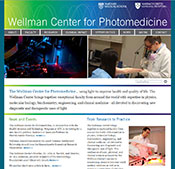 |
|
Wellman Center for Photomedicine
The Wellman Center site was designed by Hecht Design and coded by the Web Development Core. We also took most of the photographs and edited the text as it was added to the site.
The site makes use of JavaScript on the navigation bar for the home page and rotates the large home page photos each time the site is accessed. The Wellman Center has been at the forefront of the use of light in medicine for diagnostic and therapeutic applications. They do basic research, clinical and translational research, and they develop new light-based technologies for use in dermatology and cancer treatment.
|
|
 |
|
Williams Syndrome Registry
Williams syndrome is a condition caused by a copy number variation in the human genome, and this site serves as a central repository of information for Williams syndrome patients and researchers. Williams syndrome causes a wide range of health issues, and this site allows researchers who study the disease to contact those who wish to volunteer to participate in their studies. All information stored in the registry is encrypted and password-protected to meet HIPAA privacy requirements.
The Williams Syndrome Registry was founded by Barbara Pober, MD, of the Massachusetts General Hospital, in conjunction with the national Williams Syndrome Association. Dr. Pober is a medical geneticist who has studied Williams syndrome and treated patients with it for over two decades.
|
|
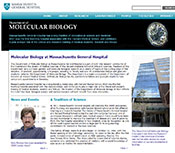 |
|
MGH Department of Molecular Biology
The Department of Molecular Biology needed an up-to-date site that followed the overall look of the new MGH clinical website, but with more flexibility for their own use, including the development of pages that would be dynamically created from databases on demand. The lab sections of the site use static code for the introductory page for each lab, and dynamic code for the people and publications sections, including biosketch text and a photograph of each lab member.
The static pages of the site have been finished and pushed to the production server, and the dynamic pages are currently in development.
|
|
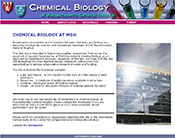 |
|
Chemical Biology at Massachusetts General Hospital
Initiated by researchers Brian Seed and Randall Peterson, the Chemical Biology website is intended to foster a sense of community among the disparate researchers working across MGH in the field of chemical biology.
The site lists and describes the labs working in the field, gives contact information for the researchers, and includes a dynamic page of resources available for sharing in the many chemical biology labs at MGH.
|
|
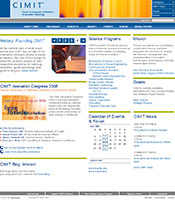 |
|
CIMIT: Center for Integration of Medicine and Innovative Technology
The CIMIT site was completed in November of 2008 and uses a variety of technologies to get their message to their diverse audiences, including researchers, donors, those in the biomedical industry, and the general public.
CIMIT brings advances in the laboratory quickly to clinical medicine and funds efforts in a number of fields, as is evident from their site.
The design was done by Communication via Design, a Boston design firm, and coded for the web by the Web Development Core. |
|
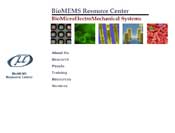 |
|
BioMEMS Resource Center
The BioMEMS (BioMicroElectroMechanical Systems) Resource Center at MGH and Shriners is a part of the Center for Engineering in Medicine. The BioMEMS Resource Center, under Dr. Mehmet Toner, is engaged in the exploration of nanotechnology and microfluidics as applied to medicine. Research areas include development of microfluidics and microfluidics applications in medicine, nano- and micro-fabrication, blood on a chip, and the living cell array technology. The BioMEMS Resource Center brings cutting-edge engineering technology to bioengineering and medical therapeutics. |
|
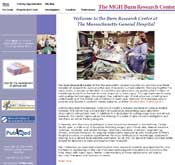 |
|
Burn Research Center
The Burn Research Center is at Shriners Burns Hospital in Boston and is funded by the National Institutes of Health. Shriners-affiliated researchers have four projects underway: Amino Acid Interrelations and Metabolism; Tissue-specific Metabolic Response to Injury; Molecular Mechanisms of Burn-Induced Insulin Resistance; and Muscle Wasting in Burns: The Role of Akt/PKB.
The Center has an extended and productive track record of scientific accomplishments, and the team is capitalizing on the use of modern technological innovations to probe how the body deals with major injury and bring these advances to use in clinical applications. |
|
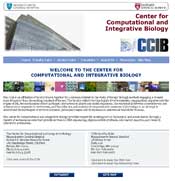 |
|
Center for Computational and Integrative Biology
The CCIB site reflects the newest of the MGH thematic centers, a place where cutting-edge research into drug and technology discovery is integrated in the broader scope of biology. The CCIB consists of a number of Harvard faculty and MGH researchers working on subjects as diverse as the creation of life from non-natural amino acids (Jack Szostak), plant pathology (Fred Ausubel), development of high-throughput tools (Ramnik Xavier), the search for evidence of life on Mars (Gary Ruvkun), muscle wasting following burn injury (Ron Tompkins), and drug and technology development (Brian Seed).
The Center for Computational and Integrative Biology provides support for investigators at the hospital and across Boston through a variety of autonomous cores that provide services including DNA sequencing, oligonucleotide synthesis, and research laboratory automation. |
|
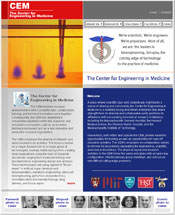 |
|
Center for Engineering in Medicine
This site went public during the summer of 2006. It highlights the research and the accomplishments of the Center for Engineering in Medicine, a group founded by Drs. Martin Yarmush and Ronald G. Tompkins in 1987. The CEM works on advanced bioengineering for the human body in such disparate fields at bionanorobotics, metabolic engineering, stem cell bioengineering, biopreservation, functional genomics, and biomicroelectromechanical systems.
There are currently ten resident faculty, over 25 affiliated faculty, and approximately 25 research fellows as well as several educational programs offered by the CEM. Facilities include a 7000-square-foot clean room used for nanofabrication of biodevices on a micro- and nano-scale, a broad variety of advanced imaging technologies, and laboratory research space operated in conjunction with Harvard, MIT, and the Massachusetts General Hospital. |
|
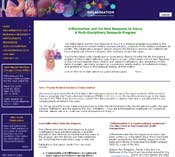 |
 |
Glue Grant
The Glue Grant, or the Inflammation and the Host Response to Injury Large-Scale Collaborative Program, is a large-scale, multi-year grant from the National Institute for General Medical Sciences for a coordinated effort among approximately twenty research institutions, universities and hospitals, with specialists in clinical medicine, molecular biology, genomics and proteomics, bioinformatics, and biostatistics, to discover the genetic differences in the body's response to sepsis and its subsequent healing trajectory. It is working toward individualized treatment for trauma and burns, targeted at the specific human genome under treatment. The Glue Grant comprises three separate sites: one for the public, one for PIs, and one for Consortium members. |
|
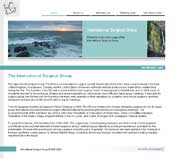 |
|
International Surgical Group
Founded immediately after World War II by surgeons from Great Britain, the United States, Australia and other countries, the ISG keeps the top surgeons in the world in touch with each other through yearly meetings and membership activities. Ron Tompkins, M.D., Sc.D., Chief of Staff of the Boston Shriners Burns Hospital and 2006 President of the ISG, commissioned this site prior to hosting the 2006 annual meeting of the ISG in Boston.
The ISG site has a public section and a private area, with dynamic pages created dynamically from a database of members, available only to members. |
|
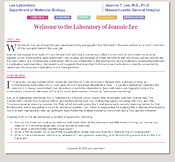 |
|
Lee Laboratory
The site for the Lee Laboratorywas released in December of 2006. Jeannie Lee, M.D., Ph.D., studies how male and female cells use a mechanism called X-chromosome inactivation to achieve equality of sex chromosome gene expression. She is also interested in the mechanistic and evolutionary relationship between X inactivation and imprinting. The site was designed to be simple and clean with light colors to allow the content to dominate.
Jeannie Lee's laboratory is located in the Massachusetts General Hospital Simches Research Center at 185 Cambridge Street in Boston. Jeannie is also an HHMI investigator. |
| |
|


















